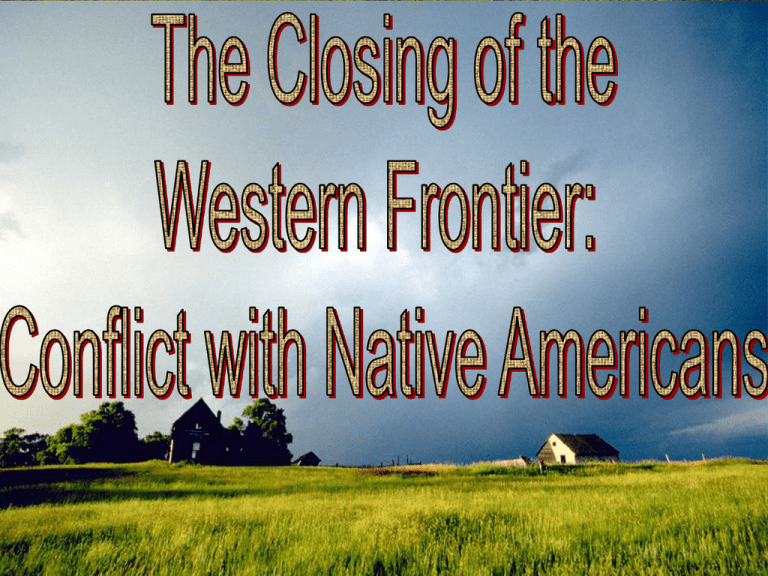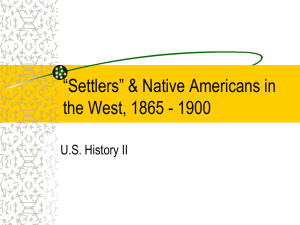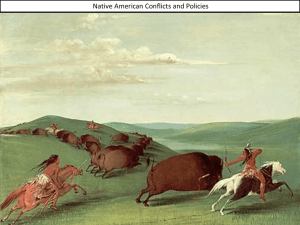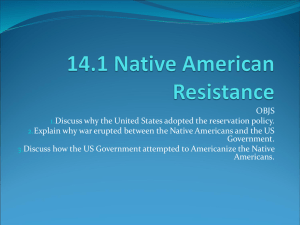Westward Expansion: Conflict with Native Americans
advertisement

The Fight for the West The Main Idea Native Americans fought the movement of settlers westward, but the U.S. military and the persistence of American settlers proved too strong to resist. Reading Focus • How was the stage set for conflict between white settlers and Native Americans in the West? • What were the Indian Wars and their consequences? • How did Native American resistance to white settlement end? • What was life like on the Indian Reservation? Stage Set for Conflict Culture of the Plains Indians Buffalo provided food, clothing, and shelter for the nomadic lifestyle of the Indians. They did not believe land should be bought and sold, and white farmers felt it should be divided. Government Policy Instead of continuing to move the Indians westward, the government changed its policy. Indian land was seized, and they were forced onto reservations. Destruction of the Buffalo The buffalo-centered way of life was threatened, with vast herds driven to extinction by reduced grazing lands and hunting for sport and profit. BUFFALO HUNT, UNDER THE WOLF SKIN 1830's - by George Catlin Importance of the Buffalo to the Indians The Indian Wars: An Overview Sand Creek Massacre Treaties The Battle of the Little Bighorn Army troops attacked and massacred surrendering Cheyenne. Congressional investigators condemned the Army actions, but no one was punished in the Sand Creek Massacre. After the massacre, Cheyenne and Sioux stepped up their raids. In return for closing a sacred trail, the Sioux agreed to live on a reservation. Other nations signed the Medicine Lodge Treaty and were moved to reservation lands in western Oklahoma. George Armstrong Custer led his troops in headlong battle against Sitting Bull and lost. The Battle of the Little Bighorn was a temporary victory for the Sioux. The U.S. government was determined to put down the threat to settlers. The Indian Wars: An Overview Palo Duro Canyon The Ghost Dance Wounded Knee The Battle of Palo Duro Canyon ended the Indian Wars on the southern Plains. With their ponies killed and food stores destroyed, surviving Comanches moved onto the reservation. The Ghost Dance was a religious movement that inspired hope among suffering Native Americans. Newspapers began suggesting that this signaled a planned uprising. The military killed Sitting Bull while attempting to arrest him in a skirmish. The Wounded Knee Massacre occurred the day after the surrender. Shooting began after a gun went off, and the fleeing Sioux were massacred. This action marked the end of the bloody conflict between the army and the Plains Indians. The Buffalo Soldiers on the Great Plains •The Buffalo Soldiers, comprised of former slaves, freemen and Black Civil War soldiers, were the first to serve during peacetime. •Once the Westward movement had begun, prominent among those blazing treacherous trails of the Wild West were the Buffalo Soldiers of the U.S. Army. •These African Americans were charged with and responsible for escorting settlers, cattle herds, and railroad crews. The Buffalo Soldiers on the Great Plains •Throughout the era of the Indian Wars, approximately twenty percent of the U.S. Cavalry troopers were Black, and they fought over 177 engagements. •The combat prowess, bravery, tenaciousness, and looks on the battlefield, inspired the Indians to call them "Buffalo Soldiers." Many Indians believe the name symbolized the Native American's respect for the Buffalo Soldiers' bravery and valor. •Buffalo Soldiers, down through the years, have worn the name with pride. The Buffalo Soldiers on the Great Plains The Buffalo Soldiers & the Indian Wars Buffalo Soldiers: A Romantic View Treaty of Fort Laramie (1851) • The U.S. government promised control of the Great Plains which was the bulk of Native American territory, for "as long as the river flows and the eagle flies". • The Native American Nations: – guaranteed safe passage for settlers on the Oregon Trail in return for promises of an annuity in the amount of $50,000 for 50 years. – allowed roads and forts to be built in their territories. • The United States Congress later unilaterally cut appropriations for the treaty to ten years' annuities, and several tribes never received the commodities promised as payments. • Significance: The treaty produced a brief period of peace. Treaty of Fort Laramie (1851) Colorado Gold Rush (1859) Colonel John Chivington Kill and scalp all, big and little! Sandy Creek, CO Massacre November 29, 1864 Red Cloud’s War or Fetterman’s Massacre 80 soldiers massacred on December 21, 1866 Captain William J. Fetterman He found himself facing approximately 2,000 Indians. Within 20 minutes, Fetterman and his command had been wiped out. He had allegedly once boasted that with 80 soldiers, he could "ride through the Sioux Nation.“ The Battle of Little Big Horn 1876 Gen. George Armstrong Custer Chief Sitting Bull • Sitting Bull and his followers were living happily and peaceably in the Valley of the Little Big Horn. • Though the winters were cold and hard, they enjoyed life, as they hunted abundant game. But because of the U.S. government's new policy, all the renegades from other tribes flocked to this location. • The wild and angry Ogalalla, Brule, Blackfoot, and Sans Arc warriors all made a home here, and then set about to attack pioneers, settlers, surveyors and prospectors. Chief Sitting Bull • Sitting Bull's followers quickly grew. • The Interior Department found it useless to delay any longer. – The army received orders to either bring in Sitting Bull, or Snuff Him Out. – Early in March of 1876 General George Crook was sent into Sioux country with a strong force of cavalry and infantry. – Crook's forces struck a big Indian Village on the snowy shores of the Powder River. – It was thirty degrees below zero; the troops were poorly led by the officer entrusted with the duty, and the Sioux had recently developed impressive new fighting tactics under a new and daring leader, "Choonka-Witko" -- known as Crazy Horse. Chief Sitting Bull • Crazy Horse received word that if he surrendered, his people would have a reservation of their own in the Powder River country. • On May 8, he knew too well that his people were weakened by cold and hunger, so he surrendered to United States soldiers at Fort Robinson on the Red Cloud Agency in northwestern Nebraska. • In September 1877, Crazy Horse's wife became critically ill, and Dr. Valentine McGillycuddy went to his camp to treat her. Chief Crazy Horse • Crazy Horse then decided to take her to her parents at Spotted Tail agency. • He left the reservation without permission, so General Crook, fearing that he was plotting a return to battle, ordered him to be arrested. • Crazy Horse did not resist arrest at first, but when he realized that he was being led to a guardhouse, he began to struggle, and while one of the arresting officers held his arms, a soldier ran him through with a bayonet. Chief Crazy Horse • Brevet Major-General George Armstrong Custer, a daring, dashing, impetuous soldier, who had won high honors as a division commander during the Civil War • He had developed a reputation as an Indian Fighter when he led his gallant regiment against the Kiowas and the Cheyennes on the Southern plains. General George A. Custer, Commanding the 7th Cavalry at Little Big Horn • Custer had entered the Sioux country two times in recent campaigns. • While Custer no doubt had experience, there were those who were superiors and subordinates who feared that Custer lacked the judgment needed to face a man like Sitting Bull on the Battlefield. • He had experienced conflict with both his commanders in the Dakota Department, and within his regiment. • It is clear, however, that everyone honored his bravery and daring. General George A. Custer, Commanding the 7th Cavalry at Little Big Horn Custer’s Last Stand! Custer’s Last Stand! Custer’s Last Stand! Significance of the Battle of Little Big Horn •The Battle of the Little Bighorn was the most successful action fought by the American Indians against the United States Army in the West. •It was part of the Campaign of 1876, an effort by the United States Government to force the Sioux tribes onto their Reservations. •The Indians' defeat of the finest cavalry unit in the United States Army was shocking because it simply was not supposed to happen. Remembering the Battle of Little Big Horn Remembering the Battle of Little Big Horn 2nd Treaty of Fort Laramie (1868) Treaty of Medicine Lodge Creek (1867) Reservation Policy Treaty of Medicine Lodge Creek (1867) • Though commonly referred to in the singular, the Medicine Lodge Treaty actually consisted of three separate treaties. • The treaties negotiated at Medicine Lodge Creek were similar in their terms, involving surrender of traditional tribal territories in exchange for much smaller reservations in Indian Territory (present day Oklahoma and allowances of food, clothing, equipment, and weapons and ammunition for hunting. Treaty of Medicine Lodge Creek (1867) • Under the first of the three Medicine Lodge treaties, the Kiowa and Comanche were compelled to give up move than 60,000 square miles (160,000 km²) of traditional tribal territories in exchange for a 3 million acre (12,000 km²) in the southwest corner of Indian Territory (present-day Oklahoma), most of it lying between the North Fork of the Red River and the North Canadian River • The tribes would also be provided houses, barns, and schools worth $30,000, which the tribes did not actually want. • Through second treaty, the Plains or Kiowa-Apache were incorporated into the first treaty; this treaty was signed by all the Kiowa and Comanche signatories of the first treaty, along with several Plains Apache chiefs. nd 2 Treaty of Fort Laramie (1868) • Guaranteed the Lakota ownership of the Black Hills, and further land and hunting rights in South Dakota, Wyoming, and Montana. • The Powder River Country was to be henceforth closed to all whites. • It ended Red Cloud's War. Treaty signing by William T. Sherman and the Sioux at Fort Laramie, Wyoming. Photo by Alexander Gardner, 1868. nd 2 Treaty of Fort Laramie (1868) • The treaty included articles intended to "ensure the civilization" of the Lakota; financial incentives for them to farm land and become competitive - and stipulations that minors should be provided with an "English education" at a "mission building". – To this end the US government included in the treaty that white teachers, blacksmiths, a farmer, a miller, a carpenter, an engineer and a government agent should take up residence within the reservation. • Repeated violations of the otherwise exclusive rights to the land by gold prospectors led to the Black Hills War. • The U.S. government seized the Black Hills land in 1877 in violation of the treaty. Resistance Ends in the West Resistance in the Northwest The government took back ninetenths of the Nez Percé land when gold miners and settlers came into the area. Fourteen years later they were ordered to abandon the last bit of that land to move into Idaho. Chief Joseph tried to take his people into Canada, but the army forced their surrender less than forty miles from the Canadian border. Resistance in the Southwest • The Apache people were moved onto a reservation near the Gila River in Arizona. • Soldiers forcefully stopped a religious gathering there, and Geronimo and others fled the reservation. • They raided settlements along the Arizona-Mexico border for years before finally being captured in 1886. • Geronimo and his followers were Chief Joseph and many others sent to Florida as prisoners of war. were eventually sent to northern His surrender marked the end of Washington. armed resistance in the area. Chief Joseph I will fight no more forever! Nez Percé tribal retreat (1877) Geronimo (right) and his warriors in 1886 Geronimo, Apache Chief: Hopeless Cause Helen Hunt Jackson A Century of Dishonor (1881) Susette La Flesche Omaha Indian lecture tour on Native American issues in the 1870s Life on the Reservation The government wanted control over all the western territories and wanted Indians to live like white Americans. The Bureau of Indian Affairs began to erase the Indian culture through a program of Americanization. Indian students could speak only English and could not wear their traditional clothing. They learned to live like Americans. The Dawes Act of 1887 broke up many reservations and turned Native Americans into individual property owners. Ownership was designed to transform their relationship to the land. The Indians received less productive land, and few had the money to start farms. Most of the land given to the Indians was unsuitable for farming. Dawes Severalty Act (1887): Assimilation Policy Carlisle Indian School, PA Native American Religious Ceremonies Native American’s continued to practice their religions & perform religious ceremonies (the Sun & Ghost Dances) despite orders from the U.S. government to move to designated Indian Reservations. Resistance to U.S. Government’s Reservation & Assimilation Policy Prompts the United States to take Action “The Sun Dance” How do you think Americans reacted when they saw this religious practice by the Indians? “The Sun Dance” • Was a very important ceremony among the Plains Indians & lasted for several days. • Before the ceremony the Indians would fast. • The camp was set up in a circle of teepees. • A tree was cut and set up in the center of the space to be used for the dance. • Ropes made of hair or leather thongs were fastened to the top of the pole. • Men tied these ropes to sticks which were stuck through the flesh of their chests or backs. • The men danced, gazing at the sun, whistling through pipes, and pulling back on the ropes until the sticks torn through the flesh. American Reaction to “The Sun Dance” • As the 19th century progressed, more and more Indian groups who practiced the rite kept whites from watching their sacred ritual. • Many Christian missionaries who were often critical of Indian rituals advocated the banning of the ceremony, and the United States government outlawed the sun dance in 1904. • Some Native American groups continued the ritual without fanfare after the ban, or have taken it up in recent decades, without the self-mutilation. • It is sometimes practiced today as part of Fourth of July celebrations. The Ghost Dance 1890 conditions were so bad on the reservations, nationwide, with starvation conditions existing in many places. The Ghost Dance Representatives from tribes all over the nation came to Nevada to meet with Wovoka and learn to dance and to sing Ghost Dance songs The Ghost Dance •Dance, painted themselves, and wore shirts and also sang. •Sioux performed it out of need of help from poverty, disease, and poor land •Taught by Paiute prophet Wovoka. The Ghost Dance: Purpose •Killed warriors that would return from the dead. •Land would become green •White men would die •There would be buffalo roaming and horses. Arapahoe “Ghost Dance”, 1890 Arapahoe “Ghost Dance”, 1890 Ghost Dance of the Oglala Sioux, Frederic Remington, Harper’s Weekly, December 1890 Impact of Ghost Dance •Dance had spread •Military leaders become nervous •Dec. 15, 1890, 43 police surround Sitting Bull’s cabin •Arrest Sitting Bull •Ghost dancers surrounded police as they are leaving •Catch–the–Bear shot a policeman •Policeman tried to fire back and shot Sitting Bull in the head by mistake •Sitting Bull dies Battle of Wounded Knee Battle of Wounded Knee Opening of the Battle of Wounded Knee, Frederic Remington, Harper's Weekly, January 1891. Battle of Wounded Knee On December 15, 1890, Sitting Bull was killed by Indian police as they attempted to take him into custody. Some of the Sioux then fled in fear, with about 100 joining Chief Big Foot on the Cheyenne River. Chief Big Foot, suffering from pneumonia and coughing up blood which would then freeze in the snow, sought to lead his tattered band of approximately 120 men and 230 woman and children to the agency at Pine Ridge. Battle of Wounded Knee Battle of Wounded Knee Chief Big Foot’s Lifeless Body Wounded Knee, SD, 1890 The Aftermath of Wounded Knee Frozen bodies being removed at Wounded Knee. Indian Reservations Today Crazy Horse Monument: Black Hills, SD Lakota Chief Korczak Ziolkowski, Sculptor Crazy Horse Monument His vision of the finished memorial. Review Questions: 1. Before the arrival of the American settlers, what was life like for Native Americans on the western plains? 2. Explain the characteristics of the Native American religion on the plains. 3. How did Americans feel about Native American religious ceremonies? How did this belief influence United States government policy regarding the Indians? Review Questions: 4. What was significant about the Indian Wars on the Western Plains? 5. What caused the Indians to stop resisting removal? 6. What did the Dawes Act, the Treaty of Medicine Lodge Creek, the Treaties of Fort Laramie, and other treaties signed between the United States government and the Indians have in common? Were there any differences? Did the U.S. government and settlers honor these treaties? Review Questions: 7. What was significant about the Indian Wars on the Western Plains? What caused the Indians to stop resisting removal? 8. What was the purpose of establishing “Indian Reservations”? 9. What was life like on the reservation for Indians? 10. How did life on Indian reservations prove to be detrimental to the survival of Native American culture?





